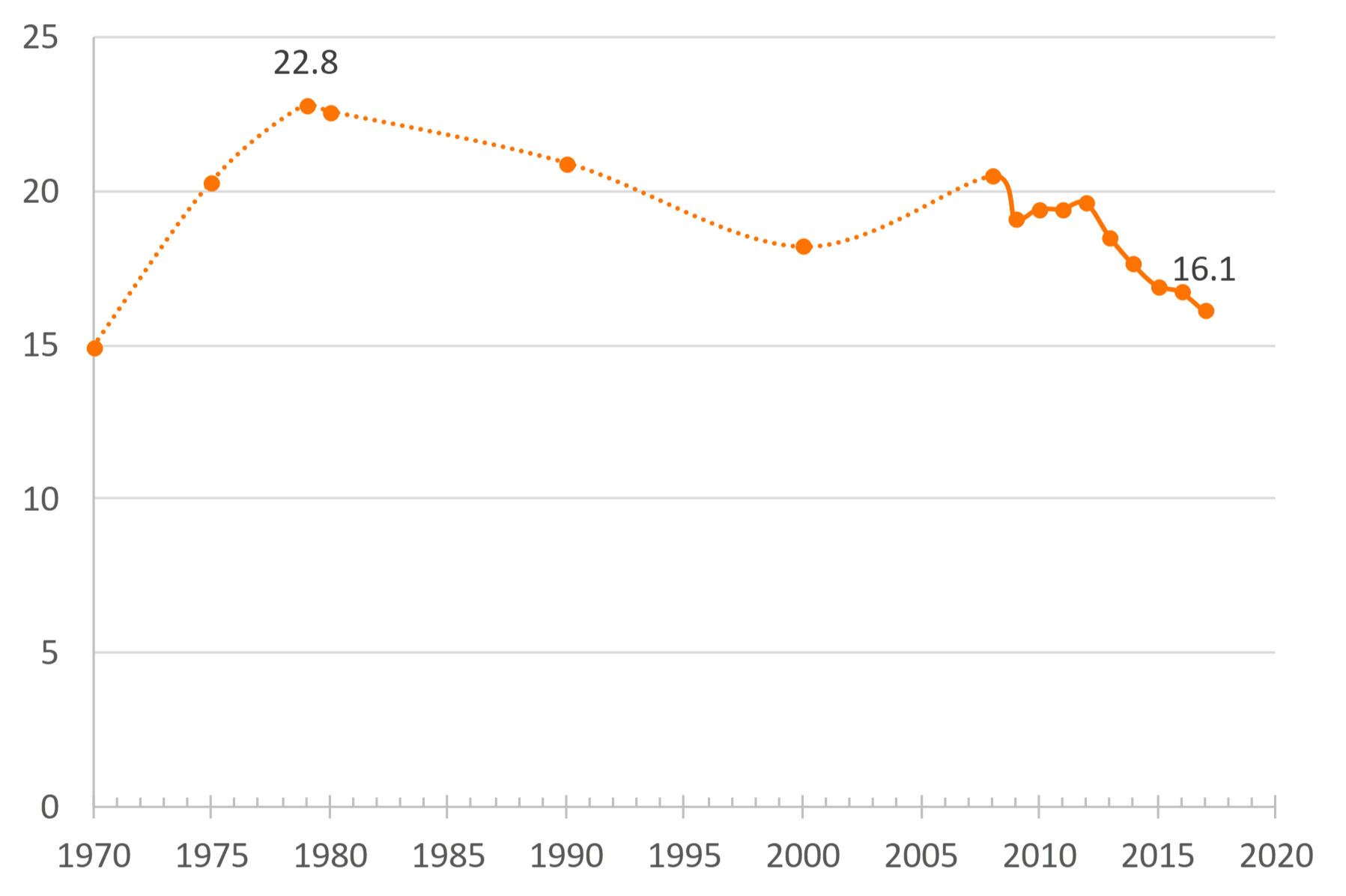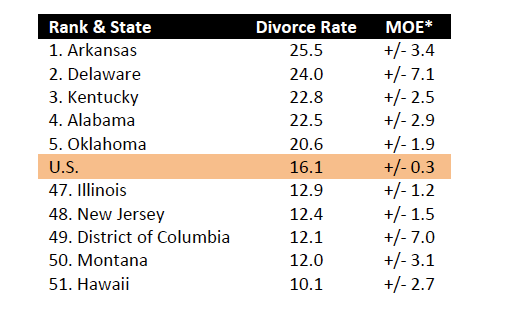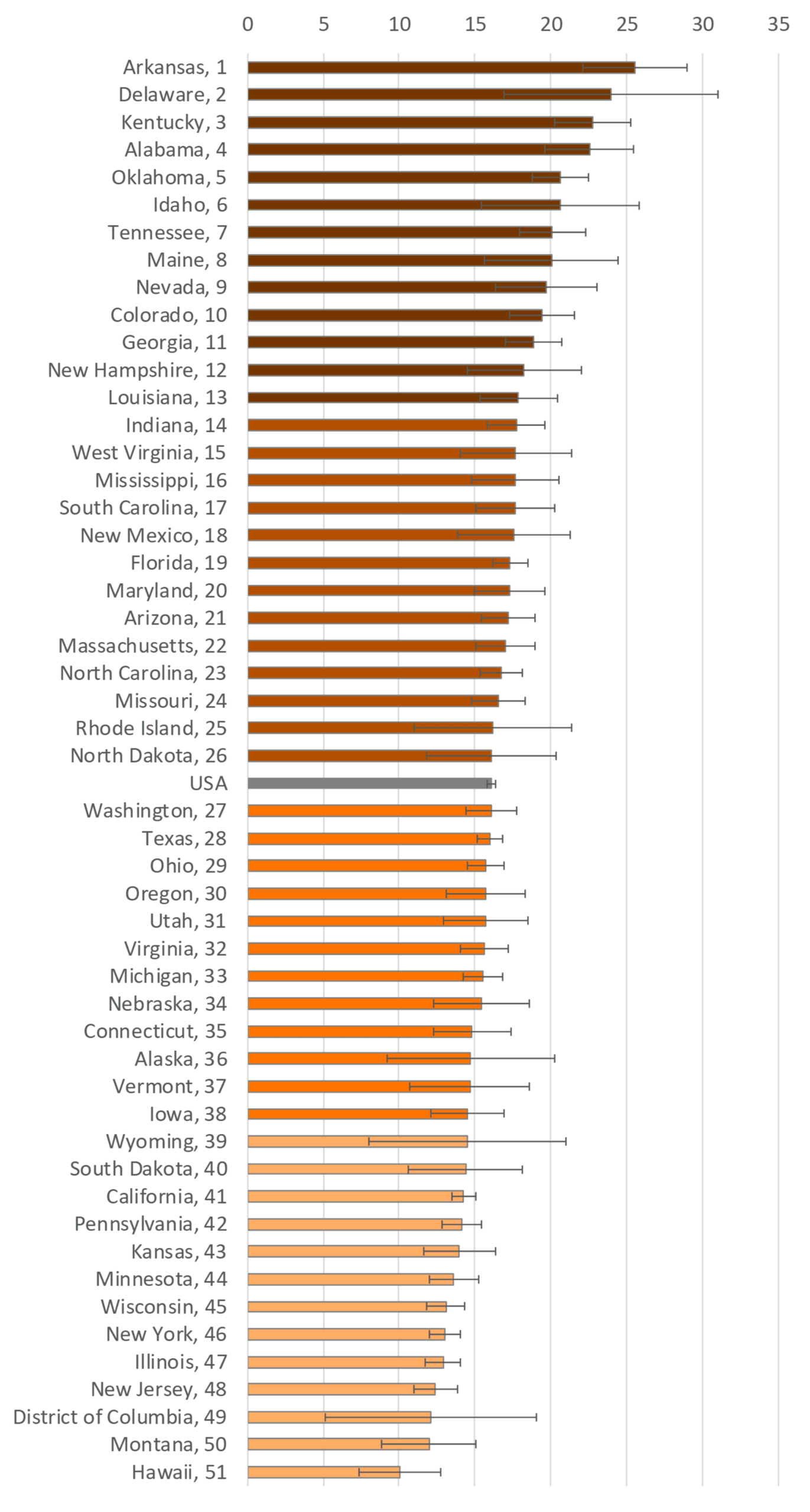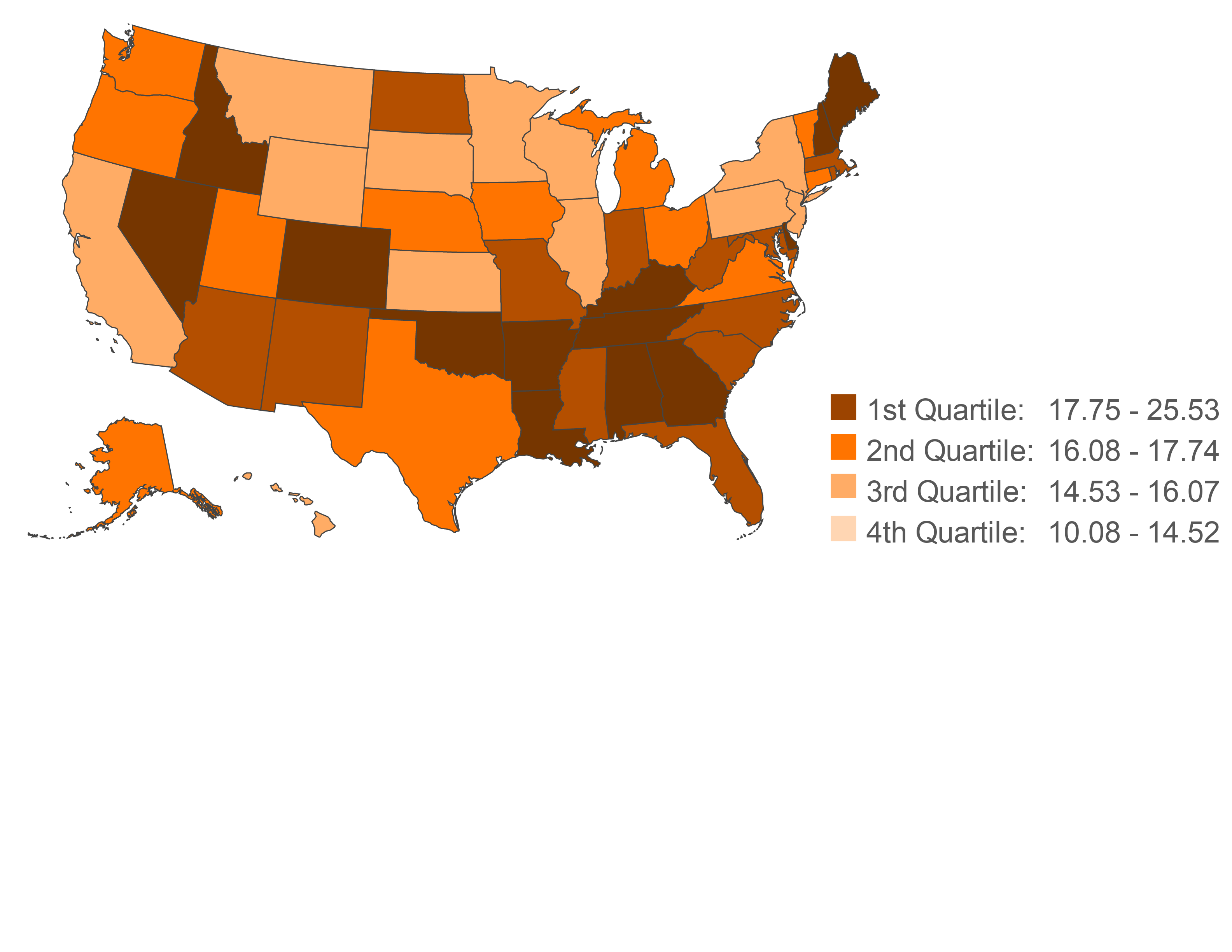Divorce Rate in the U.S.: Geographic Variation, 2017
This Family Profile has been updated with new data. Click here to access the most recent version, FP-20-25.
(Updated profiles include: FP-09-02, FP-13-14, FP-14-17, FP-15-18, FP-16-21, FP-17-24, FP-18-21, FP-19-23)

Family Profile No. 21, 2018
Author: Valerie Schweizer
Introduction
In this profile, an update to a previous profile on the divorce rate (FP-17-24), we estimate adjusted divorce rates for the nation and each state for 2017. Using American Community Survey data, we enumerate estimates of the number of divorces occurring in the last year among married women, calculate their margins of error, and provide information on their geographic variation. For detailed information on the adjusted divorce rate from 2008-2017, see Charting Marriage & Divorce in the U.S.: The Adjusted Divorce Rate.
U.S. Divorce Rate, 2017*
- The divorce rate continued to decline in 2017, decreasing from 16.7 divorces per 1,000 married women aged 15 and older in 2016 to 16.1 divorces per 1,000 married women in 2017.
- Just over one million women (1,075,500) divorced in 2017, a drop of about 23,000 from 2016, and a drop from the recent peak in 2008 of around 230,000.
- The divorce rate had decreased by 28.8% from the historical highpoint in 1979 (22.8) to 2016 (16.1).
* The divorce rate = [(number of women divorced in the past 12 months) / (number of women divorced in the past 12 months + number of currently married women)]*1000
Figure 1. Women’s Adjusted Divorce Rate, 1970-2017

Five Highest and Lowest Divorce Rates, 2017
- Arkansas continued to hold the top spot in terms of the divorce rate. In 2017, Arkansas had 25.5 marriages per 1,000 ending in divorce.
- Hawaii had a low divorce rate, with only 10 marriages per 1,000 ending in divorce. The lowest divorce rate was half as high as the highest divorce rate.
Table 1. Women’s Highest and Lowest Divorce Rates, 2017

State Rankings in Divorce Rate, 2017
- The states with the highest divorce rates (making up the 1st quartile) had rates of at least 17.9 divorces per 1,000 married women in 2017. Among the states in the top quartile, those with divorce rates that were significantly higher than the national average were Arkansas, Delaware, Kentucky, Alabama, Oklahoma, Tennessee, Colorado, and Georgia.
- The states that experienced the lowest divorce rates (making up the 4th quartile) in 2017 had fewer than 14.5 divorces per 1,000 married women. Among the
states in the bottom quartile, those with divorce rates significantly lower than the national average were Hawaii, Montana, New Jersey, Illinois, New York, Wisconsin, Minnesota, Pennsylvania, and California. - States with the highest divorce rates (1st or 2nd quartiles) were spread out around the country. However, the highest concentration was found among Southern states, with two-thirds (67%) having divorce rates falling in the top quartile.
- States in the Northeast and Midwest had the lowest divorce rates (3rd or 4th quartiles).
- Over half (54%) of Northeastern states had divorce rates in the bottom quartile.
- Over half (57%) of Mid-Western states had divorce rates in the 3rd quartile.
Figure 2. State Variation in the Adjusted Divorce Rate per 1,000 Married Women Aged 15+ by Quartile, 2017

Figure 3. Geographic Variation of Women’s Adjusted Divorce Rate Among States, 2017

References
- Clarke. S. C. (1995). Advanced report of final marriage statistics, 1989 and 1990. Monthly Vital Statistics Report, 42(12). National Center for Health Statistics. https://www.cdc.gov/nchs/data/mvsr/supp/mv43_12s.pdf
- Hemez, P. (2017). Divorce rate in the U.S.: Geographic variation, 2016. Family Profiles, FP-17-24. Bowling Green, OH: National Center for Family & Marriage Research. https://www.bgsu.edu/ncfmr/resources/data/family-profiles/hemez-divorce-rate-2016-fp-17-24.html
- National Center for Health Statistics (1974). Summary report final marriage statistics, 1970. Monthly Vital Statistics Report, 23(2), Supp.1. U.S. Department of Health, Education, and Welfare. https://www.cdc.gov/nchs/data/mvsr/supp/mv23_02s1acc.pdf
- National Center for Health Statistics (1977). Advance report of final divorce statistics, 1975. Monthly Vital Statistics Report, 26(2), Supp. 2. U.S. Department of Health, Education, and Welfare. https://www.cdc.gov/nchs/data/mvsr/supp/mv26_02s2acc.pdf
- National Center for Health Statistics (1983). Advance report of final marriage statistics, 1980. Monthly Vital Statistics Report, 32(5). U.S. Department of Health and Human Services. https://www.cdc.gov/nchs/data/mvsr/supp/mv32_05s.pdf
- National Center for Health Statistics (2001). Births, marriages, divorces, and deaths: Provisional data for January December, 2000. National Vital Statistics Report, 49(6), Associated Table 3. Department of Health & Human Services, Center for Disease Control and Prevention. https://www.cdc.gov/nchs/data/nvsr/nvsr49/nvsr49_06.pdf
- U.S. Census Bureau (2018). American Community Survey, 2017 1-Year Estimates [Table B12001]. Retrieved from: https://factfinder.census.gov/faces/tableservices/jsf/pages/productview.xhtml?pid=ACS_17_1YR_B12001&prodpe=table
- U.S. Census Bureau (2018). American Community Survey, 2017 1-Year Estimates [Table B12503]. Retrieved from: https://factfinder.census.gov/faces/tableservices/jsf/pages/productview.xhtml?pid=ACS_17_1YR_B12503&prodype=tableSchweizer, V. (2018). Divorce rate in the U.S.: Geographic variation, 2017. Family Profiles, FP-17-21. Bowling Green, OH: National Center for Family & Marriage Research. https://doi.org/10.25035/ncfmr/fp-18-21.
Suggested Citation
- Schweizer, V. (2018). Divorce rate in the U.S.: Geographic variation, 2017. Family Profiles, FP-17-21. Bowling Green, OH: National Center for Family & Marriage Research. https://doi.org/10.25035/ncfmr/fp-18-21.
This project is supported with assistance from Bowling Green State University. From 2007 to 2013, support was also provided by the U.S. Department of Health and Human Services, Office of the Assistant Secretary for Planning and Evaluation. The opinions and conclusions expressed herein are solely those of the author(s) and should not be construed as representing the opinions or policy of any agency of the state or federal government.
Updated: 04/12/2021 12:28PM

